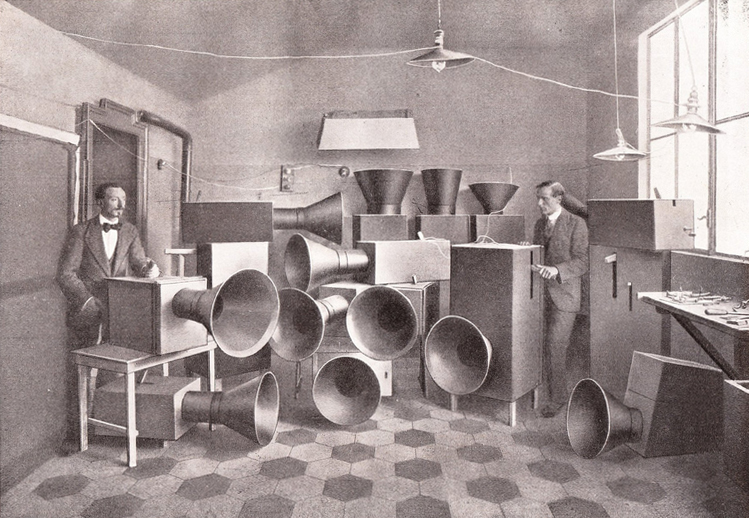
Luigi Russolo and Ugo Piatti with noise machines, Milan, 1913. Reproduced in L’Arte dei rumori (The Art of Noises), 1916
In his manifesto The Art of Noises, published in 1913, the Italian artist Luigi Russolo argues for a radical new form of music based on the sounds of modern industrial life: rumbles, roars, whistles, hisses, gurgles, screeches, and crackles. “We want to attune and regulate this tremendous variety of noises harmonically and rhythmically,” he writes. Russolo, who had until then been a painter, constructed a collection of extraordinary noise machines—intonarumori in Italian—to generate this challengingly abrasive Futurist soundscape. His ideas anticipated the development of 20th-century avant-garde sound experiments, from musique concrète, made from recordings of everyday noise, to synthetic electronic music.
The picture of Russolo and his assistant Ugo Piatti in their sound laboratory in Milan is an important document in the history of experimental music, well known to students of the subject. It was published in 1916 in a book version of the manifesto, and what you see here is the printed reproduction that is always shown, rather than a photographic print—I have never seen the original and it may not have survived. When I first encountered the image many years ago, I knew nothing about its place in the history of Futurist music. I was spellbound. The scene was achingly mysterious and seemed to imply the existence of an arcane early branch of sound technology as curious and irretrievable today as the pneumatic tube compressed-air system introduced in the 19th century to deliver the mail. I kept a photocopy in a file of unusual photos. Annoyingly, after preserving the picture for many years, at the moment I decide to write about it, the file and the copy have vanished.
For me, this has always been a metaphysical image, not a Futurist one, and I still prefer to view it outside its specific musicological context. Within two or three years, Giorgio de Chirico would paint a series of what he termed “metaphysical interiors,” and in the mid-1920s René Magritte picked up the baton in surreal paintings such as The Menaced Assassin. The atmosphere of the Russolo picture comes from similarly uncanny attributes, not least the feeling of enclosure and that there are too many objects proliferating in a tight space. The modular regularity of the hexagonal floor tiles answers the jumbled geometry of the circular, conical and rectangular units. The lever-operated noise generators in blank-sided boxes appear to depend on an unknown combination of mechanical power and improvised electrical circuitry. Everything is made deadpan and enigmatically smooth by the bleaching effects of the print process and what must surely be heavy retouching. Whatever sound the two impeccably dressed sonic conjurors are producing is unimaginably strange.
See all Exposure columns

